AMBOSELI MOBILE VETERINARY CLINIC MONTHLY CASE REPORT Reported by: Dr
AMBOSELI MOBILE VETERINARY CLINIC MONTHLY CASE REPORT
Reported by: Dr. Fredrick Ochieng Oliang’a and Ndambiri Ephantus.
Introduction
The month of November began with inconsistent light showers within the park and fairly significant precipitation in some areas surrounding the park promising some good signs against the severe drought. It is the beginning of rain and dust is quickly settling down after devastating long dry spell. This is also expected to mark the massive exodus of the wild animals from and within the swamps of Amboseli National Park into deep forested nearby conservancy areas as they look for alternative browse. Presence of foliage and water will eventually reduce the competition between human and wildlife thus dwindling human-wildlife conflict cases are expected.
This report covers a few cases that were attended just before the resident veterinarian Dr. Ephantus Ndambiri resumed from his annual leave and the cases following his return.
CASE #1 ELEPHANT COLLARING
Date: 2nd November 2016
Species: Elephant x 2
Age: Adult (30-35 years)
Sex: Male
Location: Kitirua Gate and Satao Elerai Conservancy
History
Collaring of two elephants was done in a collaborative effort to effectively monitor and understand the movement of this Key species within and beyond Amboseli ecosystem. Collaring data informs on policy decisions that would help in enhancing sustainable land use for coexistence of elephants amongst the conservation community. The elephants were collared at Kitirua gate area and Satao Elerai Conservancy.
Immobilization and Collar Placement
Both elephants were located after an aerial search and darted from a chopper using 18mg Etorphine Hydrochloride. Anaesthesia took effect within an average time of 10 minutes before recumbency. Collar placement was effectively done with the ground support team comprising competent multidisciplinary personnel.


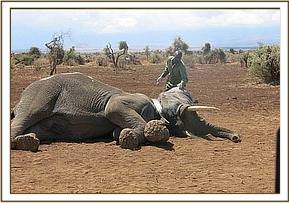

Reversal
The anesthesia was reversed using 200mg Naltrexone and recovery was smooth.
CASE#2 TREATMENT OF A SPEARED ELEPHANT
Date:
Species: Elephant
Age: Adult (30-35 years)
Sex: Female
Location: Kimana Sanctuary
History
This adult elephant was in a big herd of about 30 elephants and was observed limping and immediately reported by the sanctuary rangers. The elephant cow was observed foraging within the herd and she was in good body condition. She was limping from an overt injury on the right hind leg even though she could still bear weight on the affected leg. Some blood mixed with pus discharged from the leg while she walked.
Immobilization, examination and treatment
The elephant was darted from the vehicle using 18mg Etorphine Hcl. The anaesthesia was effective in 8 minutes and the animal went down on right lateral recumbence (lying on the affected leg). The elephant was roped and moved to a left lateral position to expose the injured leg for convenient and effective examination and treatment.
The right rear leg had a penetrating spear wound with a lateral entry point penetrating downwards and deep through the sole of the affected limb. There was no foreign object recovered from the wound and there was also no bone involvement. The soft tissue affected was fairly fresh with mild exudate of pus just starting to develop.
The wound was carefully probed for any foreign object during cleaning; Cleaning was done using copious amount of water and Hydrogen peroxide through a gauze attached to a long atraumatic forceps. Tincture of iodine and green clay was then applied using the same approach to ensure penetration through the full depth of the injury. Intramuscular injection of 15000mg, amoxicillin trihydrate (Betamox®) and 40mg of Dexamethasone 0.2% (injection Glucorton-20®) were also administered.
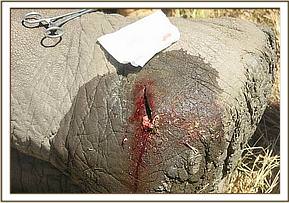

Reversal of anaesthesia was done using 200mg of Naltrexone with a smooth recovery.
Prognosis
Good
CASE #3 EXAMINATION AND MANAGEMENT OF A SPEARED ELEPHANT
Date of death: 16/11/2016
Date of postmortem: 16/11/2016
Species: Elephant
Sex: Male
Age: Adult
Location: Longepito Rombo Area
History
The elephant had initially been attended to on 30th October of a spear wound to the lateral side of the right foreleg metacarpal joint. The prognosis for the elephant was guarded because of the location of the wound. A review was carried out on 16th November 2016 after being reported by Big Life rangers as having difficulties in ambulation.
General examination
It was observed that the animal had hardly moved a kilometer since last time it was attended to. This was because of the swollen right forelimb occasioned by a pus oozing wound at lateral side of metacarpal joint. Any attempt to use or bear weight on the limb precipitated heavy grunting obviously causing severe pain. It was found browsing but could hardly move showing swinging leg lameness.
Its health status had deteriorated and he could not offer himself any protection. This put him at risk as an easy poaching target. A decision to euthanize the elephant was reached upon importantly because of trophy security and also to relief it of unbearable pain. It was put down humanely.
Postmortem Diagnosis
The wounded limb was dissected and followed the tenacious creamy pus exuding canal into joint cavity. The joint integrity was totally interfered with resulting in articular cartilage erosion, absence of synovial fluid, fibrosis of surrounding connective tissue and edema of other soft tissues. This explains why the animal could not make any useful ambulation because of severe pain emanating from the injury.


Conclusion
The spear caused fatal injury which resulted to irreversible sepsis.
CASE #4 RESCUE OF AN ELAND
Date: 17th November 2016
Species: Eland
Sex: Male
Age: Adult
Location: Maili Nne Rombo Area
History
This eland was spotted and reported by the community within the area to Rombo KWS Station who called for assistance from Amboseli Mobile Vet Unit. It was within the tomato cultivated fields and was reported to be docile. We quickly rushed there to assess the situation and rescue the candidate.
Immobilization, examination and treatment
It was darted with 7mgs Etorphine and 50mgs Azaperone in 1.5cc dart filled with 500I.U Hyalase. The animal was darted from foot as the animal was approachable. The dart landed on the right gluteal muscles and remained calm on sternal recumbence until it was fully narcotized at the edge of tomato cultivated field.


Initial examination before darting depicted a weak emaciated old bull probably poor health exacerbated by prevailing dry season. Attempts to urge it to move proved difficult and it ended up lying down in sternal recumbence. Plans were made for it to be translocated away from the community area to the nearby forest area where there is minimal human activity. With the help of the community it was manually loaded into an empty pick up using slings and a stretcher. It was placed on right lateral recumbence with head first and secured safely using ropes. The tongue was pulled out to the left side to allow drainage of any saliva and or ruminal fluids. It was transported away and released safely deep in the nearby forest.
Before revival while on sternal recumbence on the ground, it was covered against any opportunistic pathogen using 75000mgs Tetracycline, 50mgs Dexamethasone and 50ml Catosal into different muscle sites. 10mgs Ivermectin was administered under the skin to cover against endo- and ectoparasites. The dart wound was infiltrated with one Cloxacillin cream tube to avoid abscess development.
Reversal
Anesthesia was reversed using 80mgs Naltrexone Hydrochloride into jugular vein. It was left on sternal recumbence silently being fully aware of its surrounding to get up while at a far watch. The Big Life Camp nearby was alerted of the case so that they can call where necessary.
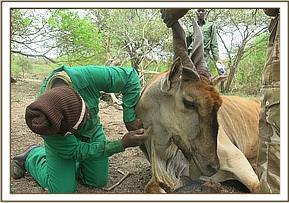

Prognosis
Was presumed to have guarded prognosis considering the poor health status and prevailing dry season causing browse scarcity.
CASE #5 TREATMENT OF AN INJURED LION
Date: 18th November 2016
Species: Lion
Sex: Male
Age: Sub adult
Location: Pipeline Tsavo East National Park
History
This lion was reported by Tsavo East KWS radio room to have been injured by buffalo while on a hunting mission. The Amboseli Vet Unit rushed to treat the lion because the Tsavo Vet Unit was not within the area of jurisdiction.
Immobilization, examination and treatment
It was immobilized using 200mgs Ketamine and 1.5mgs Medetomidine in a 3cc dart which was filled with water for injection. It was fully narcotized in five minutes. A blind fold was placed around the head while it was on sternal recumbence and then placed on right recumbence with tongue pulled to the side to allow saliva drainage.
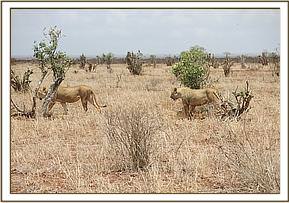

It was slightly emaciated and slightly lame on the left forelimb which had a shallow raw wound at the center of paw dorsally. The left eye was cloudy and the lateral corner of the eyelid had a pus oozing laceration. This pus was draining into the eye partially obliterating it. The left mandible had two penetrating septic wounds on the masseter muscle with one extending into the muscle and the other one just through the skin. This made the jaw swollen caudally and had pus burn on the neck skin adjacent resulting to alopecia. Another shallow pus covered wound was on the left ear pinna on inner surface. It had not gone through and its drainage was into the ear meatus. This exudate had maggots depicting that the lion had been with injuries for about a week. Chewing movements and dentition were normal. It was a member of a pride with seven members, including two adult females who all were present. They had feasted on a buffalo carcass the previous night and were found guarding it by the Tsavo Vet Unit driver who directed us to the scene.
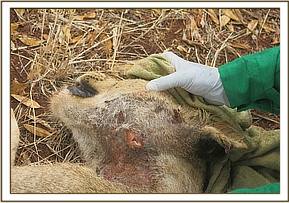

All wounds were cleaned using Hydrogen Peroxide and Tincture of Iodine carefully avoiding eye and ear meatus contact. Swabs were used to wipe any fluid in the eye and ear. The eye was infiltrated with one tube of Cloxacillin Eye Ointment and so were other wounds after topical Tetracycline wound spray. Systemically it was covered with 15ml Catosal, 10mgs Dexamethasone and 2250mgs Amoxicillin into different muscle sites. It was placed under the shrub shade for Ketamine to wear of.
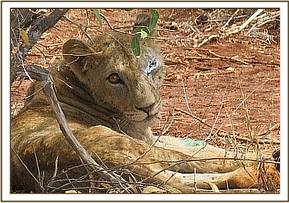

Reversal
Revival from anesthesia was done after 45 minutes since darting when it begun to flap the left ear. This was done using 20mgs Atipamezole injected into left rump muscles. It was fully awake in 17 minutes and left to join the rest of pride members who were just nearby.
Prognosis
It had favorable prognosis and will require a review after seven to ten days if sighted. This has been notified to Resident veterinarian.
CASE #6 RESPONSE TO LION INJURY REPORT
Date: 20th November 2016
Species: Lion
Pride: A lioness and 3 cubs
Location: Amboseli National Park
History
It was early in the morning when a tourist made a report to the Amboseli Tourism Warden that there was a pride which had a seemingly ill member needing veterinary attention. The Mobile Vet Unit was quickly informed and rushed there before the pride could retreat deep into the bush.
Observation
It was observed that the pride composed of four members; a lioness and her three cubs. They were found scattered but within sight of one another. The Lioness was lying down with two cubs close by while the third cub was on the wildebeest carcass near the edge of the road. All had swollen bellies, an indication that they had had their fill. Keen observation revealed that some cubs had bloody coloration on their front limbs but no member needed vet assistance. All were observed while in motion as mother picked the carcass to hide it and the three cubs followed energetically. They were left to enjoy their meal peacefully.
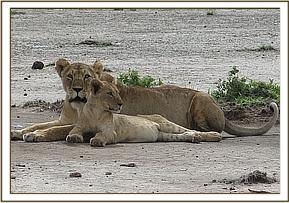

CASE #7 POSTMORTEM OF AN ELEPHANT
Date of death: Unknown
Date of PM: 25th November 2016
Species: Elephant
Sex: Uncertain
Age: Juvenile
Location: Lemong’o ; Amboseli
History
The elephant carcass was sighted by Satao Olerai security rangers on the evening of 24/11/2016. The report reached the vet unit through the Community Warden Amboseli N.P. but postmortem was postponed to the following day due to darkness.
General examination
The carcass was on sternal recumbence and the posterior side had severe maggot infestation and had been preyed upon. The two small Ivory trophies had been retrieved by the Amboseli Park rangers for safe custody and onward transmission. The carcass was swollen due to autolysis and putrefaction. A bad odour was emanating from the carcass and abdominal discharges had oozed out stretching about six meters from the posterior of the carcass portraying extensive decomposition. No skin injury or discontinuity was obviously noted from the skin covered carcass but the spine was prominent. The area surrounding the carcass had droppings suspected to have been from the rest of the family and also signs of browse on the nearby shrubs.

Postmortem Diagnosis
The carcass had undergone heavy autolysis making any meaningful postmortem findings impossible. The carcass was approximated to be more than four days old.
Conclusion
The postmortem was inconclusive but tentatively the young elephant could have gone down due to poor health (lassitude) as a result of the prevailing dry weather. This was suspected by prominence of the spine despite carcass swelling.
Follow up Cases
Ngulia elephant cow (Treated on 23.10.16)
The elephant cow treated last month at Ngulia lodge is showing promising prognosis and has now joined her herd. The swellings have gone down and the animal is regularly sighted as they come to drink water at the lodge’s water point; our visit for a repeat assessment did not succeed as she did not show up but communication from the lodge management confirms significant improvement.
Rombo elephant bull (Treated on 30.10.16)
This bull was treated for a front leg injury and her prognosis was guarded; He has not been sighted since the last treatment date but the Kenya Wildlife Service and the ‘Big Life’ Rangers are active on their search for a repeat treatment.
Kimana gate elephant cow
This elephant was in a herd near the park entrance and had a stiff legged gait; her left hind limb dragged behind as she walked. She did not have any external injury and was suspected to have dislocated the leg. She was not treated as she needed a period of monitoring prior to an informed intervention.
Acknowledgement
Much appreciation to Kenya Wildlife Service and specifically the veterinary service department for their active efforts in wildlife conservation. We appreciate the invaluable support of the Samuel J and Ethel Lefrak charitable trust through the David Sheldrick Wildlife Trust, our great and reliable conservation partners, whose effort comes through in a significant way to save the last great species on earth. God bless you all.























